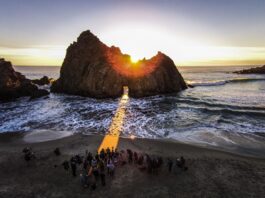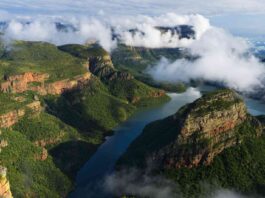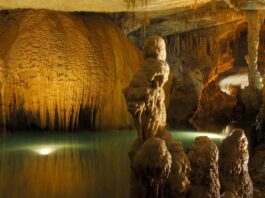The Chicxulub Crater is an impact crater buried underneath the Yucatán Peninsula in Mexico. It is one of the most significant impact structures on Earth and is associated with the mass extinction event that occurred around 66 million years ago, marking the end of the Cretaceous period and the beginning of the Paleogene period.

Geographically, the Yucatán Peninsula is a large landmass in southeastern Mexico, surrounded by the Gulf of Mexico to the west and north, the Caribbean Sea to the east, and the Bay of Campeche to the northwest. The crater itself is largely buried beneath layers of sediment and is not visible on the Earth’s surface.
Discovery and Early Studies:
The presence of the Chicxulub Crater was initially proposed by Luis Alvarez, his son Walter Alvarez, Frank Asaro, and Helen Michel in 1980. They suggested that a large asteroid impact might have caused the mass extinction event that led to the extinction of the dinosaurs.

The evidence supporting this theory came from the discovery of a layer of sediment rich in iridium, a rare metal associated with asteroids and meteors, found in rocks dating back to the time of the extinction. The researchers hypothesized that an asteroid impact could have released a significant amount of iridium into the atmosphere, leading to a global layer of iridium-enriched sediment.
Subsequent studies, including geophysical surveys and drilling projects, provided more concrete evidence for the existence of the Chicxulub Crater. In the early 1990s, an offshore drilling project called the Chicxulub Project provided core samples that contained shocked quartz and other impact-related features, confirming the impact origin of the crater.
The Chicxulub impact is estimated to have been caused by an asteroid or comet approximately 10 kilometers in diameter. The impact would have released an immense amount of energy, leading to widespread environmental effects such as wildfires, tsunamis, and a “nuclear winter” scenario with prolonged darkness and cooling.
The discovery and study of the Chicxulub Crater have significantly contributed to our understanding of mass extinction events and the role of asteroid impacts in shaping Earth’s history.
Formation of Chicxulub Crater

Impact Event and its Magnitude:
The Chicxulub Crater was formed as a result of a catastrophic impact event that occurred approximately 66 million years ago during the late Cretaceous period. The impacting body is believed to have been an asteroid or a comet with an estimated diameter of around 10 kilometers (about 6 miles). This impact is considered one of the most powerful in Earth’s history and is associated with the mass extinction event that led to the demise of the dinosaurs.
The energy released upon impact would have been staggering, equivalent to billions of atomic bombs. The intense heat generated during the impact would have caused immediate fires and triggered a series of devastating environmental effects.
Theories on the Impacting Body:
While the exact nature of the impacting body is not definitively established, the leading theory suggests it was an asteroid. This theory is supported by the discovery of shocked quartz and other impact-related features in geological samples from the Chicxulub region. The impactor’s size and characteristics align with those of a large asteroid.
The impactor is often referred to as the Chicxulub impactor, and its collision with Earth is believed to have played a crucial role in the mass extinction event, leading to the extinction of about 75% of Earth’s species, including the dinosaurs.
Geological Impact:
Effects on the Yucatán Peninsula:
- Crater Formation: The impact would have created a massive crater, known as the Chicxulub Crater, with a diameter of over 150 kilometers (about 93 miles). The immediate area around the impact site would have experienced extreme geological disturbances.
- Mega-Tsunamis: The impact would have generated mega-tsunamis, with waves reaching hundreds of meters in height. These tsunamis would have swept across the Gulf of Mexico, affecting coastlines far beyond the immediate vicinity of the impact.
- Widespread Fires: The intense heat produced by the impact would have ignited wildfires across the Yucatán Peninsula and beyond. The combination of impact-generated fires and the subsequent “nuclear winter” effect would have contributed to a dramatic global climate shift.
Immediate and Long-term Geological Consequences:
- Climate Effects: The impact would have released massive amounts of debris and aerosols into the atmosphere, leading to a “nuclear winter” effect. This would have caused a significant drop in temperatures worldwide, impacting ecosystems and contributing to the mass extinction event.
- Global Environmental Changes: The Chicxulub impact is associated with long-term geological consequences, including changes in sea level, alterations in ocean circulation patterns, and disruptions to the global climate. These changes would have had profound effects on the Earth’s ecosystems and contributed to the restructuring of life on the planet.
The Chicxulub impact event remains a pivotal moment in Earth’s history, shaping the course of evolution and providing valuable insights into the geological and environmental consequences of asteroid impacts.
Connection to Mass Extinction

The Chicxulub impact event is intimately connected to one of the most significant mass extinction events in Earth’s history, known as the Cretaceous-Paleogene (K-Pg) extinction event. Here’s how the impact is linked to the mass extinction:
1. Immediate Environmental Effects:
- Firestorms: The impact would have triggered intense firestorms in the immediate vicinity, incinerating vast areas of vegetation.
- Tsunamis: Mega-tsunamis would have swept across the oceans, affecting coastal regions globally.
2. Atmospheric Effects:
- Debris and Aerosols: The impact released a tremendous amount of debris, including vaporized rock, dust, and aerosols, into the atmosphere.
- “Nuclear Winter”: The ejected material caused a significant cooling effect on the planet, blocking sunlight and leading to a prolonged period of darkness and cooling known as a “nuclear winter.”
3. Climate Disruption:
- Temperature Drop: The combination of reduced sunlight and the blocking of solar radiation led to a rapid drop in temperatures globally.
- Impact Winter: The cooling effect persisted for an extended period, disrupting ecosystems and food chains.
4. Ecological Consequences:
- Collapse of Food Chains: The abrupt and extreme environmental changes caused by the impact and its aftermath led to the collapse of ecosystems and food chains.
- Loss of Biodiversity: Many species, including approximately 75% of Earth’s species, went extinct. This included non-avian dinosaurs, marine reptiles, ammonites, and numerous other plant and animal species.
5. Long-term Geological Effects:
- Sea Level Changes: The impact contributed to significant changes in sea levels, affecting coastal habitats and marine life.
- Ocean Circulation Disruptions: The impact disrupted ocean circulation patterns, further impacting marine ecosystems.
6. Duration of Effects:
- Long-lasting Impact: While the initial devastation was immediate, the environmental repercussions of the Chicxulub impact were felt for an extended period, with ecosystems taking thousands to millions of years to recover and evolve.
The Chicxulub impact, with its combination of immediate and long-term environmental effects, is considered a primary driver of the K-Pg mass extinction. The severity and suddenness of the changes caused by the impact event played a crucial role in reshaping the Earth’s ecosystems and paving the way for the rise of new species in the subsequent Cenozoic era.
Scientific Investigations

Methods Used for Studying the Crater:
- Seismic Surveys: Scientists employed seismic studies to map the subsurface structure of the Yucatán Peninsula and identify the buried crater. Seismic waves are used to create detailed images of the geological layers beneath the Earth’s surface.
- Drilling Projects: The Chicxulub Scientific Drilling Project, initiated in the early 2000s, involved drilling into the crater to retrieve core samples. These samples provided valuable information about the impact, including shocked minerals, impact breccias, and the stratigraphy of the post-impact environment.
- Geophysical Studies: Researchers used various geophysical methods, such as gravity surveys and magnetic studies, to analyze the physical properties of the rocks and structures associated with the impact.
Discoveries and Insights Gained from Research:
- Confirmation of Impact Origin: The drilling projects confirmed the impact origin of the Chicxulub structure through the recovery of impact-related materials, including shocked minerals and impact ejecta.
- Insights into Impact Dynamics: Analysis of core samples provided insights into the dynamics of the impact, such as the energy released, the depth of penetration, and the environmental consequences.
- Post-Impact Environmental Changes: Studying the layers of sediment above the impact helped scientists understand the post-impact environmental changes, including climate shifts, sea level variations, and the gradual recovery of ecosystems.
Chicxulub and the Dinosaurs:
Role in the Extinction of Dinosaurs:
- Immediate Impact: The immediate effects of the Chicxulub impact, such as firestorms, tsunamis, and the “nuclear winter” phenomenon, played a major role in the sudden and widespread extinction of dinosaurs.
- Ecosystem Collapse: The collapse of ecosystems, caused by the destruction of habitats and the disruption of food chains, led to the extinction of many species, including non-avian dinosaurs.
Impact on Other Flora and Fauna:
- Global Extinctions: While dinosaurs are often the focus, the Chicxulub impact caused the extinction of a wide range of flora and fauna, including marine reptiles, ammonites, and many terrestrial species.
- Selective Survival: Some groups of organisms, such as mammals, birds, and certain reptiles, survived the extinction event. This paved the way for the diversification and evolution of these groups in the post-extinction world.
Timeline of Events:
Sequence of Events During and After the Impact:
- Impact (66 million years ago): The asteroid or comet struck the Yucatán Peninsula, creating the Chicxulub Crater and triggering immediate environmental devastation.
- Immediate Aftermath: Firestorms, tsunamis, and the injection of debris into the atmosphere caused widespread destruction, leading to the initial mass extinction.
- “Nuclear Winter”: The ejected debris caused a prolonged period of darkness and cooling, disrupting global climates and further contributing to the extinction event.
- Post-Impact Environmental Changes: Over time, the Earth’s climate stabilized, but the impact had long-lasting effects on sea levels, ocean circulation, and terrestrial ecosystems.
Recovery of Ecosystems Following the Extinction Event:
- Early Succession: After the extinction event, simple and adaptable organisms, such as ferns and some mammals, quickly recolonized the devastated landscapes.
- Gradual Evolution: Over millions of years, ecosystems gradually recovered and evolved. New species emerged to fill ecological niches left vacant by the extinct organisms.
- Rise of Mammals: The extinction of large dinosaurs opened up ecological opportunities for mammals. Mammals, which had been relatively small and inconspicuous before the extinction, underwent significant diversification and became dominant in many ecological roles.
The Chicxulub impact and the resulting mass extinction event had profound and lasting effects on the Earth’s ecosystems, shaping the course of evolution and paving the way for the development of the modern biosphere.






